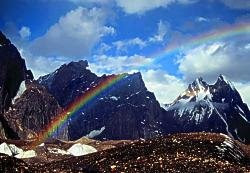
Loess is a geologically recent deposit of silt or material which is usually yellowish or brown in color and consisting of tiny mineral particles brought by wind to the places where they now lie. It is a product of past glacial activity in an area. It is a sedimentary deposit of mineral particles which are finer than sand but coarser than dust or clay, deposited by the wind. Loess is a type of silt which forms fertile topsoil in some parts of the world. Loess deposits are usually a few meters thick. One of the key characteristics of these deposits is the ‘cat steps'. The soil has few clay particles to hold it together. It is composed mainly of quartz crystals which slide easily against each other, and is therefore very subject to erosion. Because of this, there are mini-earth slides, which form the steps.
Loess was formed during the time after the Ice Age when glaciers covered a great portion of the earth. When the climate warmed up, the warm temperatures melted the glaciers creating tremendous flows of water down into a valley or river, and exposing vast plains of mud. When these plains dried, strong winds blew the exposed sediments and swept the finer materials from the flood plains into huge clouds of dust, which were deposited into the bluffs, that is, bold steep banks. As silt accumulated, higher bluffs were formed. Often several loess deposits are stacked on top of each other, because each individual glacier produced new loess deposits. Topsoils made up of loess are found in the central and northwestern parts of United States, in central and eastern Europe, and in eastern China.


















































